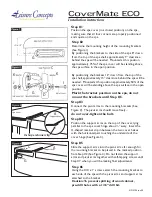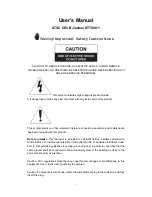
Model G0750G (Mfd. Since 5/15)
-71-
The goal of adjusting the gib screws is to remove
sloppiness or "play" from the ways without over-
adjusting them to the point where they become
stiff and difficult to move.
In general, loose gibs cause poor finishes and
tool chatter; however, over-tightened gibs cause
premature wear and make it difficult to turn the
handwheels.
Gib Adjustment
Leadscrew End Play
Adjustment
Set Screw
Bearing
Cover
Leadscrew
Flange
Bolt
Leadscrew
Figure 118. Leadscrew end play bearings.
After a long period of time, you may find that the
leadscrew develops a bit of end play. This lathe
is designed so that play can be removed with a
simple adjustment.
Items Needed
Qty
Hex Wrench 3mm .............................................. 1
Wrench 24mm ................................................... 1
NLGI#2 Grease ................................. As Needed
To remove leadscrew end play:
1. DISCONNECT LATHE FROM POWER.
2. Back out the leadscrew set screw approxi-
mately five turns (see
Figure 118).
3. Un-thread the leadscrew flange bolt (Figure
118), and slide the bearing cover off the end
of the leadscrew.
4. Clean the bearings with minerals spirits, then
dry and repack them with NLGI#2 grease.
Re-install the bearing cover.
5. With your left hand, pull the leadscrew toward
the tailstock, and thread the leadscrew flange
bolt back on until it is finger tight and no
leadscrew end-play exists.
6. Hold the leadscrew flange bolt with the 24mm
wrench, and tighten the set screw until it is
snug at the bottom of its bore.
The cross-slide and compound slide on this lathe
each use a long steel wedge called a gib that is
positioned between the component and its dove-
tailed-ways. At the end of each gib is a gib screw,
which moves and holds the gib. Depending upon
which direction the gib moves, the space between
the sliding ways increases or decreases to control
the rigidity of the cross slide and compound slide.
Before adjusting the gibs, loosen the locks for
the device so that the gibs can freely slide during
adjustment, then lubricate the ways.
The gib adjustment process usually requires
some trial-and-error. Repeat the adjustment pro-
cess as necessary until you find the best balance
between loose and stiff movement. Most machin-
ists find that the ideal gib adjustment is one where
a small amount of drag or resistance is present,
yet the handwheels are still easy to move.
Содержание G0750G
Страница 112: ... 110 Model G0750G Mfd Since 5 15 SECTION 10 APPENDIX Threading Feed Charts ...
Страница 116: ......
















































